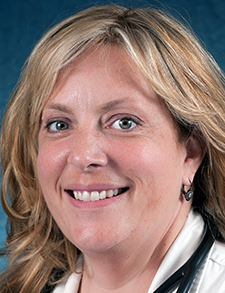
Dr. Ramanathan

Dr. Chmelik
The term hospitalist was coined in 1996 in a New England Journal of Medicine article written by Dr. Robert Wachter—often considered the father of the field. The need was clear: hospitals wanted a physician dedicated to the care of inpatients on a 24/7 basis. Hospitals and patients have benefited tremendously, and hospital medicine has become the fastest-growing medical specialty in U.S. history. But were we ever meant to belong to the hospital as our name and title suggest?
The goals have shifted
With the advent of value-based care, the goals have shifted and are now financially aligned with quality in the continuum of care rather than just one venue. With more than 25 years of being champions of the hospital, we’re uniquely positioned to help drive this change and evolve professionally in the process.
As a part of a larger medical community, are we generating value for our patients? If value were defined as an increase in quality and a decrease in cost, the answer would be “no” on both counts. As a nation, a commonly vaunted statistic is that U.S. health care spending is growing two to three times that of the nation’s Gross Domestic Product.1 Still, in terms of quality outcomes (age-adjusted mortality, disability-adjusted life years, health care access and quality, etc.), we rank far below comparably developed countries.
But as hospitalists, how accountable are we for the state of our current health care system? Undoubtedly, in terms of quality within the hospital, we’ve improved patient safety and satisfaction.
Today’s hospital is unrecognizable from the hospital of 20 years ago, thanks in large part to the hospitalists that drove change. But, in terms of measured cost, we’ve reduced it by reducing length of stay, but increased it through documentation and consultation. If we take post-discharge planning as an example, why are we not more engaged in where the patient goes next? Put simply, because it doesn’t affect us anymore. We’ve become hospital-centric and not patient-centric.
Coordinating with PCPs
The forgotten person in this whole endeavor has been the primary care physician (PCP). Once held in awe by the patient (as carer-in-chief) and hospital (as supplier-in-chief) alike, PCPs have been relegated to the role of someone looking in from the outside. The notion of that all-encompassing PCP, who knew their patients well and followed them to every medical setting, was a fallacy of course but was a dream worth dreaming.
The holy trifecta in industry and health care is time, quality, and cost. Because of lack of time, PCPs wanted to be in the hospital but couldn’t. Hospitalists want to coordinate care beyond the hospital but don’t. The cost goes up, and the quality goes down. Clearly, practice patterns have changed, and we cannot go back to the past; with the gains we’ve had within the hospital, we wouldn’t want to.
Patient value
If 50% of Medicare spending is in the acute episode of care (anchor admission plus post-acute stay, Part B, durable medical equipment, and readmissions), hospitalists are in a prime position to affect that spending if we change our goals and thought processes to that of patient value, not just hospital value.2 A growing number of provider organizations—private, hospital, and primary-care groups—are now committing to educating their hospitalists in value-based care. This is not to diminish the tremendous value they have already brought to the hospital, but now the goal is to create value beyond those four walls. But how will this evolution into value-based hospitalists occur?
We have to start with determining if admission to the hospital is even warranted. This would include observing, working with our PCP partners in turning patients around in the emergency department (ED), obtaining close follow-up, and referring patients into their network of specialists as outpatients. For those who do require admission, the advent of teleservices will give patients lower-cost alternatives, such as hospital at home and skilled-nursing facility at home directly from the ED.
Hospitalists’ incentives must be aligned with metrics that bring actual value to the patient. Examples would include total length-of-stay (LOS)/spend (in 90 days), readmissions, and post-acute utilization/next site-of-care. Using proxy measures for these end goals like advanced-care planning discussions, the number of PCP warm hand-offs, and a reduction in the number of consultations will help drive some of those more traditional numbers. We could then do away with key performance indicators that add little to actual patient care, such as the case mix index and the resultant over-focus on documentation, hospital LOS, and Hospital Consumer Assessment of Healthcare Providers and Systems, better known as HCAHPS (which we all know is an imperfect measure of patient satisfaction at best).
Maybe a partial return to our roots is in order. We could get there by working in different settings, much like a traditional internist or family physician would. To understand and appreciate the care journey patients and families endure, we should struggle along with them. We believe this will make us better holistic physicians. As often mentioned with the advent of more advanced teleservices, we wouldn’t have to be physically in a rehab or post-acute discharge clinic, per se, but could connect with those same patients remotely.
We cannot have a carte-blanche approach to all our patients. We should identify and focus on high-risk, high-opportunity patients. We need to have targeted interventions and workflows that pertain to the key metrics discussed. Examples could include early goals-of-care conversations, “meds to beds,” and an increased focus on scheduling transition appointments before leaving the hospital for those patients with multiple comorbidities, previous readmissions, and/or the elderly.
Value-based care
Lastly and most importantly, our own self-value as a profession is at stake here. As a highly subsidized group of specialists, we’ve become detached from the hospital’s contribution. Hospitals and hospital systems can no longer sustain this level of spending, and our daily census continues to rise as a result.
We continue to live in a fee-for-service world, but salaries can no longer be sustained by volume. The hospitalist community has banded together during the pandemic like never before and should have felt thoroughly appreciated. But there is a disconnect between that perception and reality, exemplified by the statistic of only a third of hospitalists belonging to our national society and a large proportion reverting to per diem or locum tenens work.
To address this new and exciting landscape for care delivery, SHM has established a special interest group (SIG) for value-based hospitalists. The goal is to discuss freely ways in which hospitalists can start bringing value to the entirety of patients’ journeys. The group will include a wealth of physician expertise flowing from payers to providers. We hope to define what quality truly is while generating ideas for the reduction in cost for the population as a whole. To get involved with the Value-Based Hospitalist SIG and explore other SIGs, visit hospitalmedicine.org/SIGs.
Value-based health care represents an opportunity for the hospitalist community to be a change agent in our current health care crisis through delivering quality and not quantity to our patients. Our horizons have just broadened beyond what our title suggests.
Learn more about SIGs and the Value-Based Care Group.
References
- CMS. National Health Expenditure Data. https://www.cms.gov/Research-Statistics-Data-and-Systems/Statistics-Trends-and-Reports/NationalHealthExpendData/NationalHealthAccountsHistorical. Accessed 3/8/2022.
- Sound Physicians. Medicare Limited Dataset, 2020. ArborMetrix analysis.
Dr. Ramanathan is the regional medical director of value-based care, northeast division, at Sound Physicians in Upland, Pa.
Dr. Chmelik is the senior medical director at Greater Texas Care & Value, and the chief of enterprise hospitalist services at WellMed Medical Management, Inc. in San Antonio.
This is a significant turn in the evolution of SHM. I would note that documentation will be more important in this effort, as value cannot be assessed without accurate and precise diagnoses and clear treatment plans. HCAHPS is admittedly poor, but needs to be improved in order to fulfill the Triple Aim. Lastly, we need to develop methods for virtual teamwork (i.e. not everyone in the same room) that allow hospitalists to collaborate throughout the day with the treatment team and bring the PCP into the team.
Thank you Dr. Rohr. It is certainly hard to get away from ‘documentation’, even within the VBC we rely on capturing HCCs to effect RAF – So your comments ring true. Please join the conversation within the VBH SIG.
Interesting article and I would say what we need to look at are:
1. Is what we do patient centered or is it attuned to the needs of the provider or the hospital?
2. Documentation. In a value based world documentation is the driver to quality and patient outcomes. HCC coding is how providers bring in the revenue to provide quality care. If you deliver great care to the patient, you should obtain the revenue needed to provide that care!
3. HCAPS. The government is driving the change and entities are being compensated by star ratings which are now increasingly being weighted by patient satisfaction. We can fight this or embrace it like we embraced EMRs and use our talent to make our patients feel like we listened to them and treat them as humans!
Health care is changing and choice is the American way and over time value based organizations will grow as the care model provides exceptional results. Hospitalists can certainly grow and be change agents in this future!